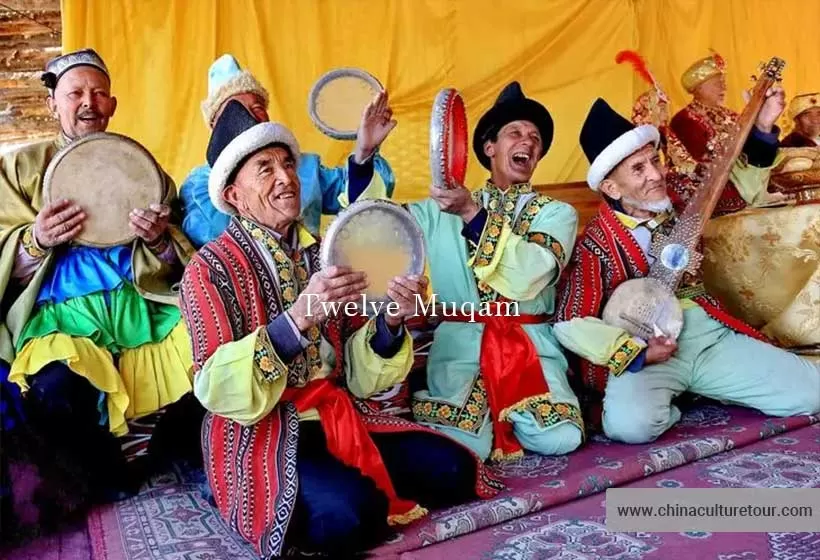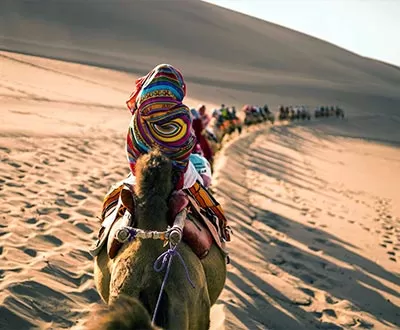Short Introduction to Xinjiang Local Culture: History, Nation, Diet, etc.
The Xinjiang Uygur Autonomous Region, located in the northwest of China, is one of the five minority autonomous regions in the country and the largest provincial-level administrative region by land area. Historically known as the Western Regions, Xinjiang was a crucial passage of the ancient Silk Road and served as a corridor for the migration and integration of various ethnic groups. It is a region where the Integrated and pluralistic culture and the integration of Eastern and Western civilizations converge.
Brief History
The original name for Xinjiang was Zhuzhou, and it was historically known as the Western Regions, meaning the western territories of China.
In 138 BCE, Emperor Wu of Han Dynasty sent Zhang Qian on a diplomatic mission to the Western Regions, establishing contact between the Western Han government and various city-states in the region.
In 60 BCE, the Western Han government established the Protectorate of the Western Regions at Wulei (present-day Luntai County), officially incorporating the Western Regions into the Han Empire's territory.
After the 9th century, the central Chinese dynasties were unable to maintain control over the Western Regions, leading to the emergence of several independent states in the region, including the Gaochang, Kara-Khanid Khanate, and Khotan kingdoms.
In 1757, the Qing Dynasty quelled the Dzungar rebellion, unifying the northwest region. In 1884, the Qing government officially established Xinjiang Province, naming it "Xinjiang", meaning "new frontier", to signify the return of former territories.
In 1949, Xinjiang was peacefully liberated, and on October 1st, 1955, the Xinjiang Uygur Autonomous Region was established with its capital in Urumqi.
Ethnic Culture
Xinjiang is a region where multiple ethnic groups coexist, creating a rich tapestry of cultural diversity. The various ethnic communities in Xinjiang influence each other, merging and assimilating to form a unique cultural landscape. The main ethnic groups in Xinjiang include the Uyghur, Kyrgyz, Kazakh, Tajik, Hui, among others, each with their distinct cultural traditions and ways of life.
Uyghur
The Uyghur people are the largest indigenous ethnic group in Xinjiang. Descendants of ancient nomadic and farming communities, they practice Islam, emphasizing respect for elders and family harmony. Known for their musical and dance talents, historical sites like the Id Kah Mosque and the Kashgar Old City bear witness to the flourishing Uyghur culture.
Kyrgyz
The Kyrgyz primarily reside in the southern mountainous regions of Xinjiang, with a lifestyle of animal husbandry. They are known for their bravery and kindness, and are celebrated for their poetry, songs, and dances. Their folklore includes "Manas", one of the world's longest epic poems, showcasing their rich imagination and unique cultural heritage.
Tajik
The Tajik people mainly live in the Pamir Plateau area of Xinjiang. Known for their courage and resilience, they were historically warriors along the Silk Road. Their folk dances are artistically captivating. Despite the harsh climate and high altitudes, the Tajik people fiercely protect their homeland with indomitable spirit.
Kazakh
The Kazakh people inhabit the northern grasslands of Xinjiang, leading a primarily nomadic lifestyle. Their culture fosters bravery and hospitality, with a deep connection to horses and exceptional horseback skills. Kazakh long songs are renowned for their unique charm, and their hospitality is legendary, making guests feel at home.
Mongolian
The Mongolian people in Xinjiang have a long-standing history, known for their bravery and wisdom. Their way of life is similar to the Kazakhs, primarily focusing on nomadism. Mongolians have a profound respect for nature and heroes, embodying a resilient national spirit. Traditional sports like wrestling and horseback riding are integral to their culture, showcasing the allure of grassland heritage.
Ethnic festivals
Seed Festival
The Seed Festival is a traditional Tajik holiday for agricultural prosperity and family happiness. It is usually held in early March according to the lunar calendar. On the day of the festival, the village chief the first seeds and blesses everyone for a smooth sowing and abundant harvest. After the sowing, people return to the village for celebratory activities.
Nawruz Festival
With a history of 3,000 years, the Nawruz Festival is the Uyghur New Year celebration. From the evening of March 20th to 22nd, the festival is heralded by beating the Nawruz drums at midnight, inviting everyone to gather for singing and dancing until dawn. The next day, Uyghur people bathe, change out of winter clothes, and enjoy Nawruz meals, exchanging these meals with neighbors as a New Year's greeting.
Eid al-Fitr
Also known as the Festival of Breaking the Fast, Eid al-Fitr is a traditional Uyghur holiday. During the ninth month of the Islamic calendar, adult Muslims fast during daylight hours. On the first day of the tenth month, Uyghur Muslims bathe, dress in festive attire, gather at mosques for prayers, and then engage in joyful celebrations.
Eid al-Adha
Seventy days after Eid al-Fitr comes Eid al-Adha, or the Festival of Sacrifice, another traditional Uyghur holiday. Uyghur families slaughter sheep and invite relatives and neighbors to their homes. Men gather at mosques to pray to Allah during this festival.
Winter Festival
The Winter Festival is a unique Tuvan holiday celebrated on the 25th day of the tenth lunar month to commemorate the passing of the living Buddha Mahakala and to pray for a safe winter. Celebrations typically include temple rituals, sheep slaughtering, and eating millet rice.
Religious Culture
Xinjiang has been a region where multiple religions coexist since ancient times. Throughout history, despite the various transformations of religions, the pattern of multiple religions coexisting has never fundamentally changed. Initially, the prevalent religions in Xinjiang were primitive religions that emerged spontaneously among ancient peoples and Shamanism that evolved from these primitive beliefs. It wasn't until the 4th century BCE that foreign religions began to enter the region, creating a landscape where Buddhism was the dominant religion among various others. This pattern persisted for over a millennium until the arrival of Islam. Over time, Islam grew and gradually replaced Buddhism as the main religion in Xinjiang.
Islamic law is profound and rich, and those who follow Islam are called "Muslims". Mosque is a place for Muslims to worship, carry out religious education and missionary activities. Islamic culture in Xinjiang has developed its own distinctive characteristics. Notably, Sufism within Islam, during its spread, integrated various local beliefs and practices, such as the "animism" concept in southern Xinjiang, ancestor worship, animal and plant worship, Zoroastrian fire worship customs, Shamanistic rituals, and pilgrimage to Mazars, thus forming a regionally unique Islamic culture.
Diet Style
Xinjiang cuisine, characterized by its halal nature, also reflects the robust and aromatic flavors typical of Northwestern Chinese culinary traditions. This regional cuisine places great emphasis on preserving the natural taste of its ingredients, skillfully utilizing a variety of spices and seasonings to create rich, flavorful dishes. The food often combines the culinary styles of the Han, Uygur, Kazakh, and other ethnic groups, resulting in a unique and diverse gastronomic profile.
Xinjiang cuisine primarily features halal dishes, with a strong emphasis on beef and lamb. Common cooking methods include roasting, grilling, and steaming. Some of the most famous dishes include Whole Roast Lamb, Dapanji (Big Plate Chicken), Lamb Polo, whose flavors lean towards being salty and spicy, creating a tantalizing dining experience that reflects the rich cultural heritage of the region.
Cultural Heritage
Xinjiang has two World Cultural Heritage sites. The first is the "Xinjiang Great Wall Resources", which was included in 1987 alongside the Great Wall. The second is the "Silk Roads: the Routes Network of Chang'an-Tianshan Corridor" listed in 2014 which includes the Ancient Cities of Jiaohe and Gaochang, the Site of Beiting City, the Kezil Caves, the Subashi Temple Ruins, and the Kezil Gaha Beacon. Additionally, throughout history, the people of Xinjiang have created a rich tapestry of intangible cultural heritage. Among these, the Uyghur Maqam, Kazakh Aitys, and Kyrgyz Manas are renowned as Xinjiang's three major cultural heritage projects.
Taboos
When traveling in Xinjiang, do not stare at people or objects. In Islamic culture, it is believed that a person’s gaze can carry supernatural negative energy, which can bring bad luck. When shopping in markets, do not look at items for too long, as this might upset the seller.
In temples, on streets, or on roads, devout believers may lay out prayer rugs and face west to pray at any time. If you encounter this, do not watch, step on the prayer rug, walk in front of the person praying, or point and discuss, as this may cause dissatisfaction.
In Xinjiang, a region with multiple ethnicities, it is taboo to drink alcohol. Halal dining forbids the consumption of pork, donkey, and dog meat, blood, and alcohol. This is a significant taboo in their daily lives and must not be offended. When dining on Han cuisine, do not invite ethnic friends to join you.
If a friendly local greets you, respond warmly. When shaking hands with a man, use both hands. Do not pass items or shake hands with your left hand, and do not initiate handshakes with women.
Customize Your Unique Xinjiang Silk Road Tour

If you are interested in one of the Xinjiang itineraries mentioned above, please contact us, and we will be happy to customize it and provide a quote tailored to your preferences.
Alternatively, if you would like to customize your Xinjiang Tour, please visit our Xinjiang Tour Customized Center. We assure you that you will receive a reply within 24 working hours.
Informative Articles for Your Xinjiang Trip
 Id Kah Mosque, Kashgar
Id Kah Mosque, Kashgar- Travel Guide: attractions, seasons, hotels, food, itineraries, etc.
- Top destinations: places to visit in Xinjiang
- Travel itineraries: best itineraries for your reference
- Local culture: brief history, ethnic culture, religion, etc.
- Weather: the best time and seasons to visit Xinjiang
- Top attractions: things to do in Xinjiang
- Cultural immersions: hands-on activities to spotlight your trip
- Unique perspective: top different things to do
- Local food: what to eat while traveling in Xinjiang
- Luxury hotels: where to stay in Xinjiang
- Xinjiang Tours: tailor-made Xinjiang Tours for your reference
GREAT FAMILY CHINA TOUR
JULY 2024 We wanted to thank Grace at China Culture tour for organizing a great tour of China. We enjoyed our Beijing - Xian-Chengdu -Guilin -Yangshuo - Shanghai trip. Our local guides Bruce in Beijing, Susan in Xian, Jane in Chengdu, Mike in Guilin and Mary in Shanghai took care of us…read more details »
Teng Han L from SINGAPORE
Ready to Create a Unique Dream Travel?


